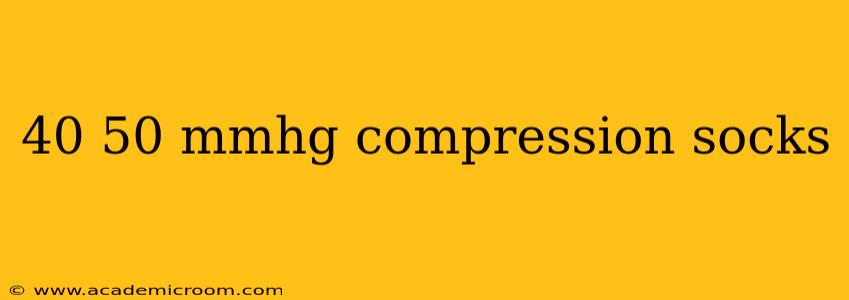Compression socks, specifically those offering 40-50 mmHg of compression, are a popular choice for individuals seeking relief from various leg-related ailments. This level of compression falls within the medical-grade range and offers significant benefits for specific conditions. This comprehensive guide will delve into the details of 40-50 mmHg compression socks, exploring their uses, benefits, and considerations.
What are 40-50 mmHg Compression Socks Used For?
40-50 mmHg compression socks are generally recommended for individuals experiencing moderate to severe venous insufficiency. This means the valves in their leg veins aren't functioning properly, leading to blood pooling and potentially causing symptoms like swelling, aching, and fatigue. Specific conditions that might benefit from this level of compression include:
- Chronic Venous Insufficiency (CVI): A common condition characterized by poor blood circulation in the legs.
- Varicose Veins: Enlarged, twisted veins that are often visible beneath the skin's surface.
- Venous Ulcers: Open sores that develop on the legs due to poor circulation.
- Deep Vein Thrombosis (DVT) Prevention (Post-Treatment): While not a primary treatment for DVT, compression therapy can assist in post-treatment recovery. Always consult a doctor before using compression socks after DVT.
- Lymphedema: A condition characterized by swelling caused by a lymphatic system blockage. Specific compression levels may need to be determined by a physician.
- Post-Surgical Recovery (Legs): To aid in reducing swelling and promoting blood flow after leg surgery. Always follow your surgeon's instructions.
What are the Benefits of Wearing 40-50 mmHg Compression Socks?
The benefits of 40-50 mmHg compression socks stem from their ability to improve circulation and reduce swelling in the legs. These benefits can lead to significant improvements in quality of life for those experiencing leg discomfort:
- Reduced Swelling (Edema): The graduated compression helps to push excess fluid back towards the heart, minimizing swelling.
- Improved Circulation: Increased blood flow helps to deliver oxygen and nutrients to the tissues, promoting healing and reducing fatigue.
- Pain Relief: Reducing swelling and improving circulation can significantly lessen pain and discomfort in the legs.
- Reduced Leg Fatigue: Improved circulation helps to reduce the feeling of tired or heavy legs.
- Prevention of Blood Clots (Post-Treatment): As mentioned earlier, they can assist in preventing blood clots post-treatment for conditions like DVT, but only under a doctor's supervision.
Who Should Wear 40-50 mmHg Compression Socks?
As previously stated, individuals with moderate to severe venous insufficiency, or specific conditions like those listed above, are typically the best candidates for 40-50 mmHg compression socks. It is crucial to consult a doctor or healthcare professional before using 40-50 mmHg compression socks. They can properly diagnose your condition, assess your needs, and determine the appropriate level of compression. Improper use of high-compression socks can potentially cause harm.
How to Choose the Right 40-50 mmHg Compression Socks?
Choosing the right pair involves considering several factors:
- Fabric: Look for breathable fabrics like cotton, nylon, or blends that wick away moisture to keep your feet comfortable.
- Length: Knee-high, thigh-high, or pantyhose options are available, depending on your needs and preference. Consider the area you need to support.
- Size: Accurate measurement is essential for effective compression. Follow the manufacturer's sizing chart carefully.
- Comfort: Ensure the socks fit comfortably without feeling too tight or restrictive.
How Long Should I Wear 40-50 mmHg Compression Socks?
The duration of wear depends on your individual needs and your doctor's recommendations. Many people find that wearing them throughout the day provides the most benefit. However, it’s essential to follow your doctor's advice. Remove them at night to allow for proper blood flow and rest.
Are There Any Side Effects of Wearing 40-50 mmHg Compression Socks?
While generally safe, some individuals may experience minor side effects such as temporary discomfort, itching, or skin irritation. More serious side effects are rare but can occur if the socks are too tight or worn improperly. If you experience any concerning symptoms, stop wearing the socks and consult your doctor.
Can I Buy 40-50 mmHg Compression Socks Over-the-Counter?
Yes, you can often find 40-50 mmHg compression socks at pharmacies, medical supply stores, and online retailers. However, always consult a healthcare professional before purchasing and wearing medical-grade compression socks. They can guide you on the appropriate compression level and ensure the socks are suitable for your condition.
This information is for general knowledge and does not constitute medical advice. Always consult with a healthcare professional before starting any new treatment or using medical-grade compression products. They can help determine the best course of action for your individual needs and health situation.
